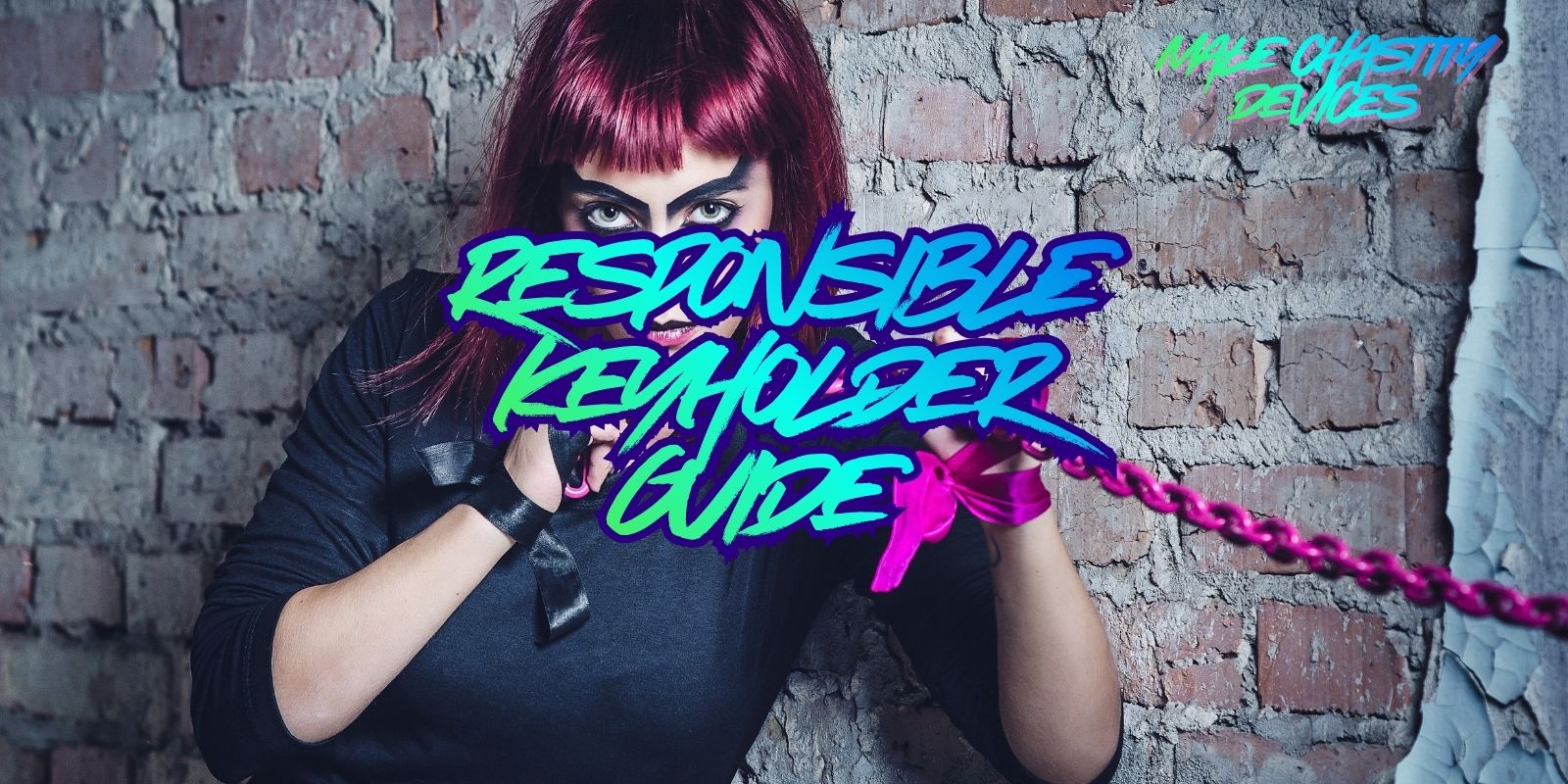Responsible Keyholder Guide — Confident And Caring Keyholder
The Responsible Keyholder Guide helps you master the art of chastity control with confidence and compassion. Learn how to build trust, set clear boundaries, communicate effectively, and prioritize your partner’s emotional and physical safety — all while deepening intimacy and respect in your D/s or chastity relationship.
Learn practical rules, negotiation tips, emotional aftercare, and safety measures so you can hold the keys with responsibility, respect and lasting trust. Being a keyholder is more than holding metal — it’s a role built on consent, communication and care. This guide explains how to be a responsible, confident and compassionate keyholder: setting boundaries, managing control, and protecting your partner’s wellbeing while deepening intimacy through chastity play.
Table of Contents – Responsible Keyholder Guide
- What is a Keyholder?
- Before You Agree: Negotiation & Boundaries
- During the Role: Communication & Care
- Long-term Responsibilities & Breaks
- Safety, Hygiene & Medical Considerations
- Key Takeaways
- FAQ
- Holding the Keys: Trust, Care & Connection

What is a Keyholder?
A keyholder is the person who controls access to another adult’s chastity device. This role can be symbolic or practical, light-play or long-term, romantic or part of a D/s arrangement. The power of the keyholder is meaningful only when it is consensual and negotiated — otherwise it becomes coercion.
Keyholding has emotional and psychological components: for the submissive, surrender can create safety and release; for the keyholder, responsibility and restraint can be empowering. Treat the role as a trust contract, not a trophy.
Before You Agree: Negotiation & Boundaries
Good keyholding starts before the lock clicks. Have a thorough negotiation that covers limits, safewords, medical needs, and the duration of locks. Use a written checklist or shared document so expectations are clear.
Discuss what “release” means (scheduled, earned, emergency), privacy boundaries (who may know about the arrangement), and contingency plans for travel or medical care. If you need a template, many communities offer negotiation checklists — or adapt a simple one from trusted chastity guides like this practical keyholder primer. (internal resource: MaleChastityDevices — Keyholder Guide).
Don’t assume your partner’s consent is permanent. Reconfirm consent at regular intervals and after any major life change (health, relocation, job stress).
During the Role: Communication & Care
Active communication is the backbone of responsible keyholding. Check in daily or at agreed moments: ask about physical comfort, emotional state, and whether any adjustments are needed. Listen more than you speak — your partner’s feedback should guide your decisions.
Provide aftercare after intense denial, teasing sessions, or emotional upsets. Aftercare can be physical (water, blankets) and emotional (reassurance, debriefing). A conscientious keyholder documents major emotional reactions and follows up in the days after a difficult scene.
Balance firmness with flexibility. Being consistent builds trust, but rigid rules that ignore distress are abusive. If something feels wrong, pause and renegotiate immediately.
Long-term Responsibilities & Breaks
Long-term keyholding can affect everyday life. Maintain healthy routines: schedule breaks, allow negotiated “time-outs,” and prevent burnout by sharing the emotional load with your partner. A smart keyholder knows when to step back and when to step up.
Remember that you’re accountable for more than the key; you are accountable for the dynamic. Track anniversaries, check-in milestones, and any “earned release” systems you agreed on. If you’re ever unsure, consult community resources or books like Male Chastity: A Guide for Keyholders for deeper structure and examples.
Safety, Hygiene & Medical Considerations
Chastity devices require regular hygiene checks to prevent irritation, infection, or injury. Agree who will perform cleaning and how often; consider quick-release options for medical emergencies. If you need device care guidance, reputable chastity suppliers and guides offer step-by-step maintenance advice.
Responsible Keyholder Guide – Know the wearer’s medical history. If they have diabetes, circulation problems, or any skin conditions, consult a medical professional before long-term locking. Emergencies happen — always carry a key or have a trusted emergency plan (neighbor, friend, or local keyholder network). Advice columns and community guides discuss emergency planning for keyholders.
Key Takeaways — Responsible Keyholder Guide
- Keyholding is about trust, not control: A responsible keyholder prioritizes consent, safety, and communication over dominance or ego. The lock symbolizes shared trust, not ownership.
- Clear negotiation is the foundation: Before engaging, discuss limits, safewords, medical needs, and emotional expectations. Written agreements help avoid misunderstandings and preserve consent.
- Communication is ongoing, not one-time: Regular check-ins about comfort, hygiene, and emotions ensure both partners stay aligned and secure throughout the experience.
- Aftercare builds emotional resilience: Post-scene discussions, reassurance, and physical comfort help integrate experiences and maintain emotional safety.
- Safety and hygiene are non-negotiable: Schedule regular device checks, use proper cleaning routines, and plan for medical emergencies — physical health sustains emotional play.
- Long-term keyholding requires balance: Manage burnout by scheduling breaks and keeping mutual well-being at the forefront. Responsibility and care should evolve as the relationship deepens.
- Accountability protects both partners: Create systems for honesty — whether through community advice, external check-ins, or renegotiations — to keep the dynamic ethical and consensual.
- Empathy turns keyholding into connection: Beyond rules and rituals, the true essence of keyholding lies in emotional attunement — guiding, protecting, and cherishing your partner’s trust.
Frequently Asked Questions – Responsible Keyholder Guide
1. How long can someone stay locked safely?
There’s no universal answer. Short-term locks (days to weeks) are common; long-term locks require strict hygiene routines and medical awareness. Always plan for regular checks and immediate release if there are signs of pain, swelling, or numbness. Community guides provide schedules and practical tips.
2. What if the wearer changes their mind?
Reconfirm consent protocols in your negotiation. If the wearer withdraws consent, the responsible keyholder must release them immediately and offer aftercare. If there’s any ambiguity, prioritize safety and emotional wellbeing over rules.
3. Can a keyholder be remote/long-distance?
Yes — many relationships use remote keyholding with trust systems (photo proof, timers, or local trusted contacts). Set clear check-ins and emergency release plans if you’re not physically present.
4. How do I avoid abusing my power as a keyholder?
Create external accountability: share agreed terms with a trusted friend, use written agreements, schedule periodic renegotiations, and never weaponize withheld release for revenge. Regularly check in on your motives and your partner’s emotional state.
5. Where can I learn more about being a good keyholder?
Community blogs, chastity suppliers, and guides are excellent starting points. Practical “how-to” and keyholder testimonials give real-world context; local kink groups and reputable online resources offer templates and mentoring.
Holding the Keys: Trust, Care & Connection
Being a responsible keyholder is a practice of stewardship — you hold a symbol of trust and intimacy. Do the groundwork: negotiate clearly, communicate constantly, maintain hygiene and safety, and never prioritize rules over a partner’s wellbeing. When done with empathy and integrity, keyholding can deepen connection, enhance erotic play, and build mutual respect.


